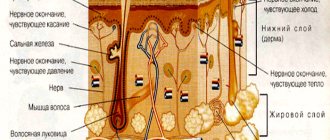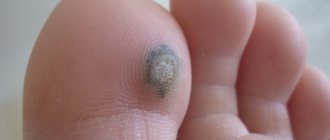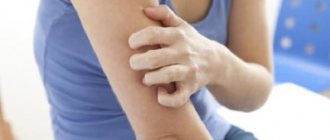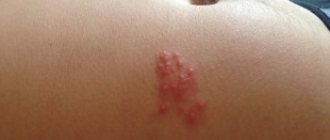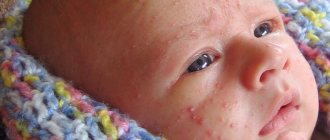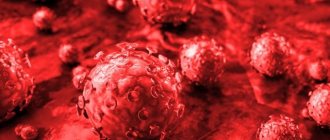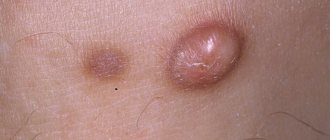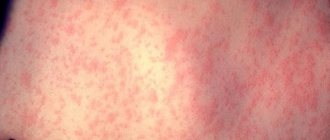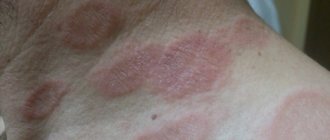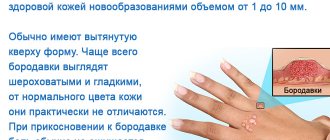Environmental experts and medical professionals represented by dermatologists associate allergic rashes with large amounts of chemicals in food, air and water. A rash due to an allergic reaction of the body is a consequence of the fact that the human body is sensitive to various irritants. The reaction appears instantly or can occur with prolonged accumulation of allergens in the human body.
Unlike other ailments, the allergy reaction appears as a pinkish rash, and the structure is not the same. In different parts of the body these are convex formations in the form of pimples. These places may be areas of the skin where it comes into contact with irritants, such as metal. Such irritations are often accompanied by swelling, intense secretion of tears, as well as itching or runny nose.
Conventionally, allergic skin rashes can be divided into several types:
- hives;
- dermatitis;
- eczema;
- neurodermatitis.
Each of these types of allergic manifestations looks different, while differing from all the others. Depending on what pathogen provoked this reaction, allergies are treated differently.
Hives
The manifestation of hives follows immediately after contact with the source of the allergy. Hives most often appear on the stomach, arms, legs, or any other part of the body. The main causative agents of this allergic reaction:
- insect bites;
- medicines;
- heat;
- cold air;
- Sun rays;
- nettle or some types of animals;
- Food;
- synthetic materials.
With hives, the allergic rash looks like pimples. They are small and bothersome with itching, reminiscent of burns from the touch of the plant - nettle. Irritation with urticaria appears quickly, blisters appear on the body, merging together, and forming plaques with uneven skin. To get rid of such manifestations, it is necessary to smear the affected areas with a special product in order to eliminate the very cause of the reaction.
Dermatitis
Due to contact dermatitis, an allergic rash appears on the facial skin in an adult. This type of rash differs from other reactions in that it occurs only in those areas of the epidermis that were in direct contact with the irritant. Such reactions can be triggered by paint, household chemicals, metals, cosmetics, latex products and even synthetic fabrics.
When a person stops contacting the irritant, the reaction in the form of skin rashes goes away. But a reaction can also appear from prolonged contact with an irritant, if it has not previously made itself felt. Dermatitis is characterized by a rash only at the site of contact with irritating substances, itching and blisters at the sites of the rash. To speed up treatment, antihistamines are prescribed, and the areas are treated with creams and special ointments.
Eczema and neurodermatitis
Eczema is a skin rash characterized by a rough surface, flaky patches, and rough spots on the skin. Initially, pink or pale pink irritations appear on the skin. The disease progresses and this changes the color of the spots, they eventually become purple and become very itchy.
During therapy, the spots decrease, but treatment may take a fairly long period. At the beginning of the disease, it has all the signs of an allergy, and this is an allergic reaction, therefore, when treating the symptoms of the disease, its cause is also treated at the same time. The spots are usually localized on the outside of the palms and on the face. If the disease is not treated for a long time, then gradually the spots will spread to other parts of the body.
As for neurodermatitis, this name in medicine refers to a chronic disease that has all the symptoms of an allergy. There may be several reasons for this disease:
- hypersensitivity to the constituent ingredients of medications;
- worms;
- infections of a chronic nature;
- digestive system disorders.
Neurodermatitis is divided into the following types: diffuse and limited. The limited appearance is characterized by the fact that when it is present, nodules form on the patient’s body and infiltration appears. They itch and uneven round plaques appear on the skin. The rash covers the neck, thighs, and can form on the genitals and on the lower half of the patient’s body. The spots may be red or appear pink.
In the diffuse type of the disease, the disease begins with itching, nodules and scratches form on the skin. Scratching becomes covered with crusts. The disease mainly affects the bends of the elbows, knees and ears.
Types of allergens
People of any age are susceptible to allergies, including infants.
Allergy in the form of acne on the face in babies occurs due to the intake of an irritating factor with mother's milk, with complementary foods and as a result of external influences (creams, ointments, etc.). In older children and adults, the immune system is more stable, but the reaction is still common. Allergens may be:
- irritant products to which a person has an individual intolerance (citrus fruits, milk, peanuts, chocolate, honey, etc.);
- cosmetics and medications containing irritants;
- plant pollen, mold, dust mites, which usually live in floor coverings (rugs, carpets), bird fluff, animal hair, dust from books;
- sun rays during prolonged exposure to the sun. Allergies on the face can also develop due to excessive use of solariums;
- insect poison;
- sweat, if a person sweats excessively;
- water if it contains a high content of impurities.
A reaction may occur if exposed to cold for a long time. There are known cases of allergies as a reaction to stress. The allergen can be the most unexpected. For example, reactions to ink applied to banknotes or to cigarette smoke are known.
- home and industrial dust;
- food products;
- animal hair;
- plant pollen;
- insect poisons;
- medicines;
- household chemicals.
Small incisions are made on the inside of the forearm, into which allergens are then injected. If the body has an increased sensitivity to the substance, then the reaction manifests itself within thirty minutes. Manifestation occurs in the form of redness or urticaria. All incisions are numbered with markers to determine the substance to which the body is highly sensitive.
Treatment of allergic rashes on the body
The cause of the allergy can be found out by contacting an immunologist. To determine the irritant, a special test is performed, and then only a doctor can determine the necessary treatment. The irritant is determined using special tests on the skin. You cannot treat allergies on your own, because this is a reaction of the human immune system to certain irritants, and you should find out what the person is allergic to.
At the initial stages of treatment, when the name of the allergen has not yet been established, they resort to local remedies to treat allergies. It is necessary, first of all, to eliminate itching and eliminate swelling. To do this, the areas affected by the allergen are moistened with water by applying a cold compress or using calamine lotion. A similar effect can also be achieved by rubbing with vodka. Vodka and alcohol help reduce itching in the affected areas and burning sensation on the skin. Treatment of the rash occurs as follows: a piece of cotton wool is torn off and alcohol is applied to it. The skin is wiped with alcohol so that the liquid covers it generously. After wiping, you can apply cotton wool to the skin for a few minutes.
Skin that is already affected by a rash must be further protected from external irritants to prevent the allergic rash from spreading across the skin. It is necessary to ensure that there are no scratches, insect bites or other damage on the affected areas of the epidermis. Contact of the affected surface with water should be limited as much as possible. Synthetic clothing is replaced with fabrics made from natural cotton; this is a prerequisite at the initial stage of allergy treatment.
Further treatment of allergic manifestations in the form of a rash in adults should consist of taking medications. To do this, use products in the form of ointments or creams. Doctors prescribe drugs for local and internal use. Alternative medicine methods cannot be excluded, such as compresses, baths and other means.
The use of traditional treatment with traditional medicine methods allows not only to eliminate the symptoms of the disease, but to avoid its relapse in the future. If the treatment is correctly selected and effective, then an allergic rash and other body reactions to irritants will no longer bother the patient.
Hemorrhagic rash (allergic spots)
The symptoms of hemorrhagic rash in adults deserve special attention. It is strongly recommended to pay attention to the fact that it is traditionally located at the level of the epidermis. It is probably located in the papillary layer. This type of rash is formed due to damage to the vascular walls by an infectious agent or certain immune complexes. It is as a result of this that a certain amount of blood on the skin is removed from the blood vessels from the cells.
When applying pressure, such a rash does not disappear, and its shade does not change. Like all other types of spots, hemorrhagic spots are located at the level of the integument, without rising above it. Depending on the size of the areas and the components of the hemorrhagic rash, several varieties are distinguished:
- petechiae is a point element that may not even be visible to the naked eye, even a child’s;
- purpura - up to one cm, for example, on the back;
- ecchymosis (bruise) - more than three mm in size, reminiscent of chickenpox.
READ ALSO: Where does a rash on the body come from and what to do about it
The causes of a hemorrhagic small rash on the skin can be various factors, for example, the use of certain medications or infectious diseases.
Drugs
Antihistamines play an important role in the treatment of rashes caused by allergies. Particularly effective are those taken orally. So, doctors prescribe Diphenhydramine, Claritin, Tavegil, Suprastin and other medications prescribed together with calcium gluconate.
Additionally, doctors can prescribe sedatives, this could be “Valerian”, “Novopassit”, “Moonwort tincture” and so on. If the rash covers a large area of skin, and the tissues are swollen, then you should consult a doctor. Treatment in this case will consist of hormonal corticosteroids, which are administered intramuscularly or intravenously. Among these funds: “Nasobek”, “Tafen nasal”, “Flixonase” and others.
Taking hormonal drugs is possible only within the walls of a medical institution and under the supervision of a doctor. This is very important, because such medications are prescribed only for serious indications and have many side effects.
Drugs against allergic rashes can be divided into first and second generation drugs. Among the first generation drugs are the following:
- "Suprastin" - this remedy effectively eliminates the symptoms of urticaria and allergic dermatitis. It also copes with such an unpleasant symptom as itching. The effect of such a medicine quickly wears off due to the inability of the active substance to accumulate in the human body.
- "Peritol" - a medicine that eliminates allergy symptoms, copes with headaches and helps improve appetite. The product is good at treating allergies caused by cold.
- "Tavegil" - eliminates skin redness and itching.
- "Diphenhydramine" - eliminates signs of allergies. Taking it relieves vomiting, skin inflammation and cough. But the side effects of this drug lead to the fact that a person may suffer from urinary retention, drowsiness and drying of the mucous membranes.
Medicines that belong to the second generation:
- “Fenistil” is similar in its action to first-generation drugs, but causes drowsiness.
- "Zyrtec" - relieves allergy symptoms well and is quickly eliminated from the body.
If a person already has signs of an allergy in the form of a rash, then self-medication is not appropriate here. When choosing a drug at a pharmacy kiosk, you can harm yourself, or at least waste your money and not expect any effect. In any case, consultation with a dermatologist is necessary. You need to know that if antiallergic drugs are chosen correctly, then the following effect is observed from their action:
- in the patient, the manifestation of inflammation in irritated areas decreases;
- the infection does not penetrate through the damaged epidermis;
- allergy symptoms such as dryness, burning, itching and redness disappear;
- the spread of the rash further throughout the body is also prevented by taking the right medications.
When choosing medications for internal and external use, you need to pay attention to ensure that they do not contain those components that will cause the spread of an allergic reaction. Therefore, in modern medicine, doctors try to use anti-allergy remedies made from natural ingredients.
Alternative medicine
To combat allergy symptoms, there are also traditional medicine methods. But you should remember that they are used very carefully. When treating, you need to follow the recipes exactly, observing all the specified proportions; if this is ignored, then the roots and herbs can harm your health.
If an allergy appears due to contact with dust, then it is treated with the help of rose hips and dandelion. You will need to take three tablespoons of crushed dandelion roots and two tablespoons of rose hips. All ingredients are passed through a meat grinder, and a tablespoon of corn silk, four tablespoons of St. John's wort, a spoonful of chamomile, five spoons of centaury and two spoons of horsetail are added to the mixture. To prepare the medicine, take the resulting mixture into a tablespoon and pour it with a glass of cold water overnight.
The product is infused overnight, and after that it can be cooled and strained. You can store the infusion in the refrigerator, and take a third of a glass three times a day if you have allergies. When taking this remedy is started, hardness may appear, and they are lubricated with menovazine. The effect of this treatment can be observed within a month. They continue to take the infusion for up to six months, and during this period it is not advisable to take alcohol.
Prevention
Preventing rashes from an allergic reaction involves using allergy ointments and creams before coming into contact with allergens. They must be applied to the skin in the place where the irritating substance is expected to come into contact. This helps create a barrier to protect the skin.
You can protect the skin without using ointment; for this, your hands are protected, for example, with rubber gloves, and your respiratory tract is protected with a respirator. This is how it is necessary to work with acids, alkalis and other substances. At home, it is best to use non-aggressive household chemicals for cleaning and washing. You can choose hypoallergenic detergents and powders.
If a person is exposed to direct sunlight for a long time, then it is necessary to protect the skin using creams, hats, glasses and other means. You can wear clothing that covers your entire body or use an umbrella. Such weather manifestations should be avoided if a person is sensitive to temperature changes. It is necessary to use protective equipment in cases where insect bites may occur, and if a person is aware of his reaction to these phenomena.
If allergies often occur to food, then you should exclude foods that may cause allergies from your menu. But for the purpose of prevention, they review not only the diet, but also the lifestyle. The functioning of the immune system and its strength will depend on the lifestyle. If the allergy manifests itself repeatedly, then the following foods should be removed from the diet:
- cocoa;
- honey;
- factory-made sweets;
- chocolate;
- eggs;
- sugar and the like.
In addition to those foods that can cause allergies, a person can experience a specific reaction of the body to other foods. And the reaction to a dish can only be characteristic of one person. Frequent stressful situations can also contribute to aggravation of reactions. If stress and negative emotions often bother a person, then it is necessary to change their lifestyle in order to improve their health.
Popular causes and types of allergic rashes in adults
An allergic rash can appear due to various factors, for example, there is an allergy to bananas, chicken or citrus fruits, and alcohol. In addition, an equally rare physiological reaction is the occurrence of skin changes due to the sun or alcohol.
Tip: In order to distinguish between these reactions, it is important to know everything about how they manifest themselves and look.
Allergy to bananas
An allergic reaction to bananas in adults can be quite rare. Among all the most common allergens, the presented fruit is classified as a medium allergen. It can provoke specific cross-reactions that extend to other names, for example, peaches or watermelons.
A reaction to bananas can manifest itself as significant itching of the skin of the body, which will subsequently spread to the oral cavity, larynx and lips, and back. Among the main manifestations, dysfunction of the digestive system is identified, namely abdominal pain, diarrhea and vomiting.
Some adults with banana poisoning may experience a prolonged runny nose, swelling of the mucous membrane of the mouth or even nose, rash and numerous rashes. The attack is relieved through the use of antiallergic drugs; in more complex cases, gastric lavage is used. Prevention of the condition involves eliminating bananas from the diet.
For chicken meat
Not everyone can consume chicken meat calmly and without the risk of developing allergies. Most often, such reactions are inherited. The most active provocateurs of such reactions are components called purines. They are the ones who influence the formation of such symptoms: redness, which can form in one place or spread over the entire surface of the body. In addition, experts pay attention to:
- acquisition of significant wateriness in the whites of the eyes;
- swelling of not only the tongue, but also the lips;
- redness in the eye area or itching near the eyelashes.
An allergy to chicken or an allergy to the face in an infant can provoke itching, in which the entire body itches and tingling in the inside of the mouth. It should further be noted that some people may experience respiratory or, for example, gastrointestinal symptoms, namely coughing, minor sneezing, nausea or vomiting. To stop an attack, antihistamines are used; in more severe cases, gastric lavage is used.
For citrus fruits
In adults, allergies to citrus fruits are quite rare; in the vast majority of cases, this is typical for children. Experts note that this can be influenced not so much by the substances contained in the oranges or grapefruits themselves, but by the chemical components with which they are treated - biphenyl, fungicides and many others. Manifestations can be very different: from allergic enterocolitis to an asthma attack or allergic stomatitis. In the most severe situations, anaphylactic shock is likely to develop, which can only be treated in a hospital setting.
When consuming citrus fruits, the patient is recommended to be prescribed antihistamines, and if the condition is aggravated, hormonal drugs are recommended. Enterosorbents must also be prescribed, allowing the intestines to be treated as well.
In the sun
Photodermatitis, or sun allergy, is a pathological condition, the occurrence of which is associated with an increased degree of sensitivity of the skin to sunlight. The leading symptoms of the disease should be considered redness and inflammation of the skin, its peeling. In addition, the skin of the back and other parts of the body may itch or even experience a burning sensation.
The most difficult processes are prevention and treatment, especially with severe reactions. For this purpose, special cream formulations and certain medications can be used: hormonal or immunomodulatory.
Red spots due to alcohol
Allergies to alcoholic beverages can have different symptoms, but most often we are talking about the formation of red spots. They are formed as a physiological response to impurities and additives in certain drinks. The body reacts to alcohol in this way much less often. Paying attention to the features of symptoms, I would like to note that:
- red spots on the skin are symptoms of the initial stage, which gradually turn out to be more and more complex;
- as the reaction develops, the spots merge and begin to form one whole, and the itching also intensifies;
- There is a deterioration in general well-being, and then a runny nose develops, as a result of which the nose can be very itchy.
READ ALSO: Cream for blackheads on the face at the pharmacy * Best
Further, the degree of susceptibility becomes aggravated, and the person quickly becomes drunk and develops problems with the digestive system.
Advice: Avoiding such an attack in adults is possible only by abstaining from drinking alcoholic beverages.
In cases where it is necessary to stop an allergic reaction, they resort to gastric lavage. Many people wonder, what is urticaria?
For synthetics
Allergic reactions to synthetics occur quite often and they can occur not only in adults, but also in children. The main reasons for this are: mechanical irritation of the most sensitive areas of the skin of the body, back, as well as a reaction to dyes and chemical components used to process the fabric.
Symptoms of this include redness, rashes and peeling, and the skin in the affected area becomes very itchy. To treat this condition, it is recommended to stop wearing synthetic clothing. It is important to normalize your lifestyle by giving up bad habits. Speaking about drug treatment, attention is paid to the use of antihistamines, ointments and creams.
For electronic cigarettes
Electronic cigarettes cannot be considered much safer than regular cigarettes. They also contain aromatic additives, glycerin, propylene glycol and other ingredients that can cause allergies. The most active in terms of provoking allergies are those names that contain at least a minimal amount of nicotine. In any case, if a person experiences coughing or itching when interacting with them, it is strongly recommended that they stop using e-cigarettes. Otherwise, anaphylactic shock or various hemorrhagic reactions are likely, the treatment of which is problematic.
On the water
Water intolerance, namely aquagenic urticaria, is encountered extremely rarely. The reason for this reaction is not the water itself, but the additional components it contains. Additional factors should be considered aggravated immunity due to the use of antibiotic components, chronic kidney pathologies, as well as immunoglobulin deficiency.
Symptoms of the condition include various skin changes: from micro burns on the back or rashes to irritation and significant dryness. Treatment is prescribed depending on the allergy symptoms in an adult and the specific type of substance, as is the case with alcohol.
On detergents on hands
The vast majority of detergents contain fragrances, fragrances, alkalis and acids, as well as other components. That is why an allergic reaction on the skin of the hands is not uncommon. Paying attention to the symptoms, I would like to note:
- redness, severe irritation or even a small rash;
- peeling and itching;
- severe dryness up to the formation of bleeding cracks that will itch very much.
For the purpose of prevention, it is recommended to abandon the drug that provokes such negative reactions, as well as improve the condition of the skin and immune background. This will allow the body to show greater resistance to such allergens and help answer the question of whether there is an allergy to cold.
For chlorine in the pool
The reaction to bleach manifests itself due to its active chemical composition, and it begins immediately after the composition penetrates the skin area. Symptoms may vary depending on the area of penetration of the component. For example, if we are talking about the eyes, it is redness and burning, if it is about the nasopharynx, then it is a cough or runny nose.
The most dangerous are its vapors, which can affect the entire surface of the human body. The treatment method may be solely prevention, completely eliminating any contact with bleach.
Advice: If it gets on your skin in the pool, it is recommended to take a shower and consult a dermatologist.
Hamster allergy symptoms
When noting symptoms of hamster allergy, they include itching in the eyes, runny nose and sneezing. Aggravated forms of such allergies in adults can provoke a dry cough, severe and prolonged wheezing, and difficulty in the respiratory process. In addition, all kinds of rashes on the skin and body, including hemorrhagic ones, are likely.
Symptoms of an allergy to deodorant
Symptoms of an allergic reaction to deodorant can manifest as various small rashes or redness. In addition, peeling of the skin, swelling, nasal congestion and even rhinitis can be identified. Sneezing and increased breathing should be considered no less pronounced symptoms.
READ ALSO: How long to stay in the hospital after removal of a wen
For metal
After prolonged contact of the skin with the metal, the latter’s ions penetrate into the human body through the upper layer of the epidermis. Due to this, there is a significant impact on the chemical composition of cells, which will give an active physiological response. Speaking about other reasons, experts pay attention to the chemicals present and their intolerance. Allergy symptoms manifest themselves in changes in the skin and an increase in temperature. Treatment will be most effective if you avoid contact with such metals.
For rubber gloves
In the vast majority of cases, such reactions occur on natural latex fibers. It is also obtained from the sap of the rubber tree, which provokes allergies. Its formation can be avoided by using vinyl or acrylic varieties. When coming into contact with such gloves, a person may experience a sore throat or itching, a runny nose, as well as irritation in the lip area, which will be very itchy. For effective treatment, it is recommended to use antiallergic tablets or cream formulations.
Treatment of allergic rashes during pregnancy
When treating an allergic rash in pregnant women, it is necessary to eliminate the source of the allergy. After this, the doctor should make appropriate recommendations. It is best to treat such an ailment using traditional medicine, since such methods have a low likelihood of side effects. But the use of such means requires medical advice, since certain methods may be prohibited in each specific case.
Treatment of allergic rashes in pregnant women occurs mainly with the use of local remedies:
- A decoction of oak bark used as compresses.
- Rose hip oil. It is applied to the affected areas several times a day using gauze pads.
- Eczema can be treated well with apple cider vinegar. Vinegar can be replaced with birch sap.
- You can make elecampane ointment with your own hands and use it to treat allergic rashes. To make such a remedy, you will need to take the rhizome of elecampane and chop it. A handful of raw materials is mixed with five tablespoons of lard without salt. This mixture is boiled for 15 minutes and filtered. The product, while it is still hot, is poured into a jar, and then the areas of tissue that are peeling, itching and inflamed are lubricated with it.
- The juice of the Kalanchoe plant is often used to treat rashes. One part of the juice is diluted with three parts of water, and then the rash is wiped with the resulting liquid.
- If the skin is very itchy, then you can eliminate the unpleasant manifestations with the help of juices and tinctures of various plants. For these purposes, horsetail, hawthorn or pansy are used. For decoctions, burdock, elecampane, chestnut or blood-red geranium can be used. You will need to take two teaspoons of the raw material, pour 0.5 cup of boiling water over it, and then boil for a few more minutes. Such decoctions are added to the bath when bathing.
- Common cocklebur is also suitable for treatment; for therapy you will need its juice. Apply the juice to the affected areas. In winter, decoctions are made from this plant. To prepare the decoction, you need a glass of boiled water, which is poured into a tablespoon of chopped herbs. The mixture is boiled for another ten minutes, then it is infused for half an hour. This decoction is used to apply washes or lotions to the affected areas.
- Itching can be eliminated by using a salt solution. A cotton cloth is moistened with the solution and then applied to the sore spot. After the procedure, irritation tends to intensify, but then all symptoms disappear.
During pregnancy, treatment of the rash is possible with the following antihistamines for internal use:
- “Chlorpyramidine”, “Suprastin”, which are prescribed only when the allergy is acute.
- "Fexadin", which is prescribed to pregnant women, having previously assessed the risks. If the risk of complications is higher than the beneficial properties, then it will not be prescribed.
- "Allertek" is a drug used after the first trimester of pregnancy.
- Claritin can be prescribed to pregnant women only if there is a serious risk of deterioration in the health of the fetus or the life of the mother.
- "Clemastine" or "Tavegil" is used in cases where the allergy is severe and can negatively affect the health of the fetus and mother.
The use of drugs from the following list during pregnancy is strictly prohibited:
- "Astemizole", which has a toxic effect on the fetus.
- “Pipolfen” or “Piperacillin” are not recommended for use not only during pregnancy, but also during breastfeeding.
- "Terfenadine." This remedy may cause the fetus to lose weight.
- Diphenhydramine can cause miscarriage or premature birth.
To prevent the development of an allergic rash on the body of the expectant mother, she needs to minimize contact with household chemicals, as well as with new decorative cosmetics. As for perfumes, deodorants and eau de toilette, their use is also not recommended due to the fact that they can cause an allergic reaction.
Pets can also cause allergies, so it is not recommended to acquire new pets. Animal fur is a strong allergen, and therefore, if there is a dog or cat at home, cleaning must be done regularly. Regularly ventilate the home, vacuum carpets, pillows and upholstered furniture.
Thus, a rash of allergic origin can appear on the body upon contact with various allergens. This symptom is accompanied by other signs, such as itching, redness and deterioration in general condition. Manifestations of allergies are treated depending on what caused the disease. To determine the cause of the disease, consult a doctor; self-medication is not appropriate here.
Features of treatment
There are primary and secondary elements. Primary ones include those formed independently due to pathologies or external causes. Secondary - those that arose against the background of the first as a result of healing or complications.
Primary
This category includes:
- Roseola. The spot is small in diameter, irregularly shaped, pinkish in color.
- Spot. Large flat roseola of irregular shape from 3 to 30 mm.
- Erythema. Large red spots are formed when spots formed by vasodilation join together.
- Hemorrhage. Pinpoint hemorrhage in the form of a small spot of red or purple color. As it recovers, it turns yellowish-green and yellow.
- Papule. A voluminous element, sizes vary from 2 to 25 mm, shape and color are similar to roseola or spot.
- Tubercle. Dense, voluminous formation from 2 to 20 mm long. It has a white middle due to the accumulation of infiltrate.
- Knot. Limited compaction extending deep into the skin. The size varies from very small sizes, in some cases, to a chicken egg. It occurs due to the accumulation of infiltration in the subcutaneous tissue.
- Blisters. A raised, cavitary, itchy pale element from 2-15 cm. It has a round shape and is pale in color.
- Bubble. An element measuring from 1 to 5 mm, representing a detachment of the skin, with transparent contents. When dry, it forms a crust.
- Bubble. The cavity element, up to 3-5 cm in diameter, is located in the upper layers of the skin.
Secondary
They are a consequence of the development of processes occurring after the appearance of the primary rash.
Let's look at them:
- Flake. Accumulation of keratinized cells and adjacent layers of the epidermis. Formed on primary elements.
- Erosion. Superficial skin defect.
- Abrasion. Violation of the integrity of the epidermis due to scratching.
- Ulcer. A defect that reaches deep layers of skin, muscle and bone tissue.
- Scar. Closure of the defect with fibrous tissue.
- Lichenification. An area of thickening of the epidermis.
Pemphigoid
Chronic skin disease of an autoimmune nature. Mainly affects older people. The symptoms are similar to some forms of pemphigus. Manifests itself as tense bubbles of varying sizes.
Depending on the location of the rash, several forms of the disease are distinguished:
- Bullous. The rash is located in the groin area, armpits, inner thighs, palms and soles.
- Scar-like. Affects mucous membranes.
- Gestational. Develops during pregnancy and is localized in the upper part of the body.
Dermatomyositis
Pathology of connective tissue, in which smooth and striated muscle fibers are affected and motor dysfunction develops.
The most common symptoms include:
- muscle weakness;
- strong increase in temperature;
- rash of the erythema type;
- visceral symptoms.
Treatment is based on hormonal therapy. In advanced cases, the disease has an unfavorable prognosis.
Herpes
It manifests itself as a vesicular rash on the mucous membranes and lips, also in the area of the external genitalia.
Most often caused by herpes simplex virus type 1, less often 2. Symptoms:
- It starts with redness and burning.
- Later, a tubercle forms and turns into a vesicle.
- At the last stage it dries out and falls off.
Treatment is carried out with a drug based on acyclovir, valacyclovir or famciclovir.
After entering the body, the virus remains there forever and is characterized by a relapsing course. Transmitted by contact.
Scabies
The causative agent of the disease is the scabies mite. Transmitted through the use of common hygiene items. The incubation period lasts from hours to weeks, most often symptoms appear on the second day after infection.
These include:
- skin itching, worse at night;
- rash;
- subtle grayish stripes are traces of passages.
Due to severe itching and scratching, infection may occur. The main medications are sulfur ointment, permethrin and others.
A skin disease in which inflammation develops due to blockage of the mouth of the hair follicle. Most often appears in adolescents, risk factors: hormonal disorder, stress. It can develop with chronic diseases and infections.
There are many varieties that appear in the form of:
- open and closed comedones;
- papular rash;
- nodules;
- pustules
For treatment, a local remedy is used that prevents the formation of comedones, reduces sebum production, and has an anti-inflammatory effect.
Candidiasis
The disease is caused by the proliferation of fungi of the genus Candida, which are constantly present in the human body. The trigger for activation of the flora is a decrease in local immunity caused by poor hygiene, taking antibiotics or other factors.
There is no rash as such with thrush, but the surface of the skin takes on a reddish tint and is very itchy, as are the mucous membranes. The most common localization is the oral cavity, external and internal genital organs. A characteristic symptom is a white, cheesy discharge with a sour odor.
A type of skin and dermatological diseases caused by a virus, manifested by formations with a depression in the center. It does not pose a threat to health, but causes inconvenience and is a cosmetic defect.
The rashes are localized on the neck, genital area, and armpits. After recovery, immunity is not developed and re-infection is possible. There is no specific therapy
Eczema
Also called allergic dermatitis. It is a skin pathology manifested in the form of various rashes provoked by exposure to an allergen. Mostly such a reaction is caused by food products, less often by plant pollen, household chemicals, and materials. The following stages of the disease are distinguished:
- Erythematous. Accompanied by itching and redness of the skin.
- Papulovesicular. Characterized by rashes in the form of papules filled with liquid.
- Getting wet. The blisters burst and release serous fluid.
- Cortical. dry out and become covered with a light yellow crust.
Treatment includes examination by a dermatologist, blood tests and allergen tests, and diet. Prevention - avoiding exposure to allergens.
Demodex
A skin disease that develops as a result of mite infestation. It begins mainly in adolescence and is accompanied by the formation of acne, pustules and red spots on the face. The affected areas are moist and smell unpleasant.
Diagnosis is carried out by microscopic examination. Treatment is carried out with sulfur ointment and a special skin care regimen. Complications include the development of other dermatological diseases: dermatitis, acne, rosacea.
HIV rash
The rash is the first sign of infection and develops in the first weeks after infection. Often leads to the appearance of various pimples and blemishes. The intensity may vary. If the rash is a consequence of the use of antiviral drugs, it will appear in the form of areas raised above the skin (drug-induced dermatitis).
Most often, HIV rashes appear on the shoulders, chest, face, abdomen, or arms. Please note that the rash is not a source of infection.
The general name for several infectious diseases accompanied by mental pathologies against the background of severe fever. The cause is infection with bacteria - intracellular parasites. Carried by lice.
Symptoms:
- heat;
- intoxication;
- facial redness and conjunctivitis;
- decrease in pressure;
- myocarditis;
- redness of the mucous membranes of the mouth;
- increased heart rate.
When the skin is touched, hemorrhages remain. Antibiotics are used as well as medications to reduce symptoms.
Toxic shock
A systemic disease that is life-threatening. The causes of development are infection with staphylococcus and streptococcus.
It manifests itself as redness of the oral mucosa, a rash in the armpits and groin, shaped like a burn, a rapid increase in body temperature, the appearance of cold symptoms, low blood pressure, and dizziness.
In later stages - skin necrosis, blood poisoning, peeling of skin tissue on the soles of the hands and feet, blepharitis, conjunctivitis.
Prickly heat
It is a type of dermatitis that occurs due to excessive sweating or skin irritation. The main difference between the disease and similar ones is the location of the rashes: with prickly heat, they are localized in places of greatest sweating - in the folds, armpits, and on the back.
Clinically manifested by a small rash of pink or reddish color, accompanied by itching.
A viral disease transmitted from person to person and characterized by general intoxication and rashes. Today, smallpox is considered defeated thanks to vaccination.
First, the general symptoms of infectious diseases develop - fever, aches, chills. The disease is often accompanied by signs of nausea and vomiting. On the 4th day a rash appears, transforming into papules and blisters that burst and leave marks.
Syphilis
A disease caused by Treponema pallidum and manifests itself in the form of hard chancre throughout the body. It is transmitted sexually and through contact with contaminated human body fluids.
There is specific treatment that often leads to complete recovery, but as the disease progresses, it affects internal organs, including the nervous system, and can lead to death.
Cold allergy
Exposure is characterized as a special reaction of the immune system, the cause of which is specific processes in the body. Most often these include: immune disorders, autoimmune and oncological diseases, chronic processes, infections.
Allergies in the human body begin due to the response of the human immune system to foreign proteins. As a result of this, a powerful release of histamine occurs, which triggers the process of negative reactions. The main reasons for the appearance of allergies on the face include:
- low air temperature;
- unfavorable environmental conditions in the form of sharp and gusty winds;
- direct exposure to ultraviolet rays;
- consumption of highly allergenic foods;
- the use of certain medications that have a strong effect on the human body. This applies to antibiotics and sulfonamides;
- close contact with plants, the pollen or spores of which provoke the development of allergic spots on the face;
- interaction with pets, to whose fur a person may become allergic;
- dust mites;
- low-quality or incorrectly selected cosmetics;
- constant stress or nervous tension;
- living in a poor environmental situation;
- hereditary predisposition to the appearance of allergic reactions on the face and other parts of the body;
- Frequent deep cleansing of the face, which leads to depletion of the upper layer of the epidermis.
- Food products;
- Medicines;
- Seasonal manifestations (pollen);
- Insect bites;
- Chemicals contained in cosmetics and household chemicals;
- Dust, feathers, wool.
- contact dermatitis. Rash, water blisters, redness - the result of contact with household chemicals;
- eczema. Burning, itching, inflammation, purulent processes begin.
- atopic dermatitis. Occurs on the face, elbows, and abdomen. Weakened immunity and a weak digestive system contribute to the onset of the disease;
- toxicoderma. A severe form of allergy occurs after taking medications. Inflammatory redness of the epidermis develops, less often blisters;
- hives. The name arose from the analogy with the sensations after a nettle burn. Accompanied by blistering and itching.
Reviews
Marina Agoneva, 34 years old, Illichevsk.
Of course, you can treat allergy symptoms using traditional methods. It all depends on what type of disease it is. If its manifestations are not so pronounced, then you can try to be treated with unconventional methods. For example, I tried the method with eggshells, and it helped me, although I have suffered from allergies for a long time, I have it innately.
But my friend recently had an allergy; it was triggered by a scabies mite. It was scabies, but it started with a rash similar to an allergy. Such a rash cannot be cured with folk remedies; its treatment requires medications such as Spregal, Lindane or Permethrin. Such preparations come in the form of solutions or sprays.
You should consult a doctor and follow all his instructions. If the allergy is a reaction to detergents, then its treatment should begin with the elimination of the irritating substance. And if you need to come into contact with detergents and cleaning products, then protect your hands with gloves.
Nadezhda Rumyantseva, 26 years old, Izmail.
I'm allergic to dust. It is impossible to cure such a disease completely; so far I have only managed to cope with its symptoms. I regularly clean my house, I have already removed all the carpets in the apartment so that dust does not collect on them and I try not to come into contact with pillows and other dusty things. It's a little easier this way. But in addition to regular wet cleaning, I also take medications and antihistamines.
Nikolay Polishchuk, 30 years old, Sumy.
I recently discovered small pimples on my body. The rash was on the shoulders, elbows and back. I suspect that this happened because of the tangerines, I ate a lot of them before. I didn’t go to the hospital, I decided that it would go away on its own. And indeed, the rash went away after some time. Of course, I no longer ate tangerines, or citrus fruits in general. The only thing I drank was Enterosgel.
Preventive actions
To prevent allergic reactions you need to follow some recommendations from doctors:
- proper nutrition;
- no contact with allergens. It is useful to keep the house clean, regularly do wet cleaning, and not eat intolerable foods;
- change of residence, if possible. This applies to those who are highly sensitive to pollen or poplar fluff;
- regular ventilation of residential premises to prevent the occurrence of fungus.
A properly selected course of treatment will help get rid of external and internal manifestations of allergies. But every contact with an allergen will worsen a person’s condition, which will lead to resumption of the disease. To avoid relapse, you must follow a few simple rules. The main preventive measures are:
- Compliance with a special therapeutic diet.
- Introducing foods rich in vitamins, minerals and other nutrients into the diet.
- Elimination of all kinds of stress, emotional experiences and overexertion from life.
- Choose household chemicals carefully.
- Active sports.
- Choose all cosmetic products correctly.
- Compliance with personal hygiene rules.
- Clean and ventilate the apartment regularly.
- When exposed to the sun for a long time, use special skin protection products.
- During treatment, strictly adhere to the dosage prescribed by the doctor, as well as the period for taking the medications.
Allergic reactions on the face are extremely unpleasant phenomena. They bring a person not only a feeling of discomfort, but also a lot of negative emotions. All this together can negatively affect a person’s future life. Therefore, if you notice the first symptoms of the onset of an allergy on your face, you should immediately seek qualified medical help.
